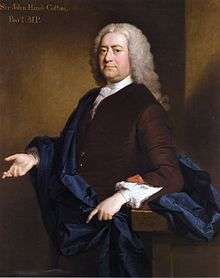Sir John Hynde Cotton, 3rd Baronet
| Sir John Hynde Cotton | |
|---|---|
 Portrait by Allan Ramsay, 1740 | |
| Treasurer of the Chamber | |
|
In office 1744–1746 | |
| Monarch | George II |
| Prime Minister | Henry Pelham |
| Preceded by | Sir John Hynde Cotton, 3rd Baronet |
| Succeeded by | Richard Arundell |
| Member of Parliament for Marlborough | |
|
In office 1741–1752 | |
| Member of Parliament for Cambridge | |
|
In office 1727–1741 | |
| Member of Parliament for Cambridgeshire | |
|
In office 1722–1727 | |
| Member of Parliament for Cambridge | |
|
In office 1708–1722 | |
| Personal details | |
| Born | 1686 |
| Died |
4 January 1752 (aged 66) Park Place, St. James's, London |
| Resting place | Lanwade, Cambridgeshire |
| Political party | Tory |
| Children | Sir John Hynde Cotton, 4th Baronet |
| Education | Westminster School |
| Alma mater | Emmanuel College, Cambridge |
Sir John Hynde Cotton, 3rd Baronet (bap. 1686 – 1752) was an English Jacobite MP. The historian Eveline Cruickshanks called him "one of the most zealous Jacobites in England".[1]
He was the son of Sir John Cotton, 2nd Baronet, of Lanwade and Madingley Hall, Cambridgeshire who had been himself M.P. several times for Cambridge. John Hynde was educated at Westminster school and Emmanuel College, Cambridge.[2]
After an MP deserted the Tories and made a speech loyal to Sir Robert Walpole, Cotton criticised him to Walpole, saying “That young dog promised that he would always stand by us.” Sir Robert replied: “I advise my young men never to use always.” “Yet”, said Cotton, stammering, “you yourself are very apt to make use of all ways.”[3]
Horace Walpole wrote that Cotton "had wit and the faithful attendant of wit, ill nature; and was the greatest master of the arts of the House, where he seldom made but short speeches, having a stammering in his elocution, which however he knew how to manage with humour. In the end of Queen Anne's reign he was in place; during Sir Robert Walpole's administration constantly and warmly in opposition; and was so determined a Jacobite, that though on the late coalition he accepted a place in the household and held it two years, he never gave a vote with the court, which argued nice distinction, not only in taking the oaths to the King (for that all the Jacobites in Parliament do) but in taking his pay and yet obstructing his service: and as nice in the King's ministers, who could discover the use of making a man accept a salary, without changing his party".[4]
He married twice: firstly Lettice, daughter of Sir Ambrose Crowley of Greenwich and secondly Margaret, the daughter of James Craggs. He was succeeded by his only surviving son, John Hynde Cotton, child of his first wife.
Notes
- ↑ Eveline Cruickshanks, Political Untouchables. The Tories and the '45 (Duckworth, 1979), p. 40.
- ↑ "COTTON, Sir John Hynde, 3rd Bt. (c.1688-1752), of Madingley Hall, Cambs". History of Parliament. Retrieved 2012-04-15.
- ↑ Horace Walpole, Memoirs of King George II. I: January 1751 - March 1754 (Yale University Press, 1985), p. 21, n. 10.
- ↑ Walpole, pp. 21-22.
-
 "Cotton, John Hynde". Dictionary of National Biography. London: Smith, Elder & Co. 1885–1900.
"Cotton, John Hynde". Dictionary of National Biography. London: Smith, Elder & Co. 1885–1900.